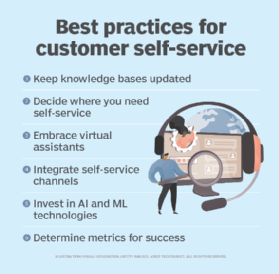
Getty Images/iStockphoto
6 customer self-service best practices
Customer self-service best practices, such as the use of virtual assistants and omnichannel access, can reduce contact center wait times and enhance overall CX.
When organizations empower customers to help themselves with self-service technology, they can improve CX and sales.
Voice channels may never go away, and they continue to rank as the second-highest customer interaction channels behind email. However, many customers prefer to handle their issues themselves or through the help of virtual assistants. To enhance CX, contact center leaders can follow customer self-service best practices, such as updating knowledge bases, using virtual assistants and embracing omnichannel capabilities. In fact, self-service knowledge bases can improve customer ratings, revenue and agent productivity, according to the Metrigy study "Customer Engagement Transformation: 2022-23."
Explore six ways that CX leaders can optimize customer self-service performance.
1. Update the knowledge base
All self-service strategies depend on a knowledge base. However, most organizations fail to continuously update content, search and media types in their knowledge bases. In addition, many organizations use multiple knowledge bases, each of which may contain information that conflicts with others.
Before customer service leaders implement or expand their self-service strategies, they should consolidate, modernize and update their knowledge bases to provide a strong foundation for customer support.
2. Identify common customer issues
Certain issues, such as return policy questions, lend themselves to self-service more effectively than others. CX, IT and business leaders should discuss the types of issues and questions customers may have and decide which interaction channel would be best for each point.
For instance, if customers regularly bombard an organization's contact center with questions about the company's return policy, the CX team could create an FAQ page that clearly explains the policy and then point customers to that page when they ask.
3. Use virtual assistants to direct customers
When customers enter a self-service channel -- an organization's website, mobile app, customer or FAQ portal -- they want to get information or resolve a problem. A pop-up virtual assistant can ask a few simple questions to guide customers along the right self-service path or escalate the conversation to a live agent. Either way, virtual assistants can get customers what they need and keep satisfaction ratings and technology functionality high.

4. Offer omnichannel capabilities
Often, when customers enter self-service channels, they must move to other channels to resolve their issues. For example, customers may begin their self-service journeys on an FAQ page, then move to a chatbot to a live agent chat to screen sharing.
If customer service leaders don't integrate self-service channels, this lack of cohesion can frustrate customers because they must repeat themselves. Agents, too, become frustrated because they don't have a full view of the customer's interactions, which makes problem resolution more difficult.
Only 21.4% of contact centers have omnichannel capabilities, according to Metrigy's study. However, these capabilities improve the customer and employee experiences because they let agents track customer interactions across all channels.
5. Embrace AI technologies
Customer service leaders should regularly update their knowledge bases so they can give customers the most up-to-date company, product and service information. Many organizations use AI and machine learning in their knowledge bases to identify areas that need upgrades and automate regular content updates.
6. Measure success
After customer service leaders implement a self-service strategy, they should measure its success to determine whether it meets its goals. Data points, such as customer satisfaction scores and revenue increases, can indicate the self-service strategy's success or failure. If the results fail to meet CX leaders' expectations, the CX team can work to improve performance and create a better self-service strategy for customers.





